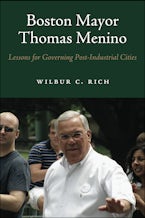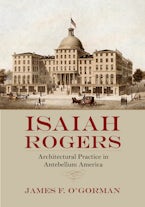- Home
- The Makers of Trinity Church in the City of Boston

The Makers of Trinity Church in the City of Boston
Edited by James F. O'Gorman
Published by: University of Massachusetts Press
256 Pages, x 0.70 in, 61 b&w illus., 16 color illus.
Other Retailers:
Since its dedication in 1877, Trinity Church on Copley Square in Boston has been widely regarded as one of the most important and successful monuments of American architecture. It has long been hailed as the cornerstone of the career of America's first celebrity architect, H. H. Richardson. But architecture is not solely the expression of individual genius. Buildings result from collaboration and compromise. They are the concrete manifestations of competing needs, desires, and expectations expressed through clients, building committees, designers, bankers, engineers, builders, decorators, and others. The Makers of Trinity Church in the City of Boston recognizes and celebrates this collaborative effort.
While critics often speak of the church as Richardson's creation, this collection of essays, written by leading scholars in the field, recognizes and assesses the individual contributions of the rector, Phillips Brooks; the chairman of the building committee, Robert Treat Paine; the builder, O. W. Norcross; and the decorator, John La Farge, as well as Richardson. The book includes the first study of the furnishings of the interior by the architect's office and features chapters on the stained glass designers Sarah Wyman Whitman and Margaret Redmond, as well as the architect Charles D. Maginnis, whose remodeling of the chancel in the 1930s brought the building to its full glory. These architectural collaborators are rarely given the recognition they receive here, although the absence of any one of them would have produced a very different result. Such omissions would have significantly diminished this towering landmark of America's cultural heritage.
In addition to the editor, contributors to the volume include Keith Bakker, David B. Chesebrough, Kathleen A. Curran, Erica Hirshler, Keith N. Morgan, Thomas M. Paine, Virginia Chieffo Raguin, Milda B. Richardson, Theodore E. Stebbins Jr., and Charles A. Vandersee.
While critics often speak of the church as Richardson's creation, this collection of essays, written by leading scholars in the field, recognizes and assesses the individual contributions of the rector, Phillips Brooks; the chairman of the building committee, Robert Treat Paine; the builder, O. W. Norcross; and the decorator, John La Farge, as well as Richardson. The book includes the first study of the furnishings of the interior by the architect's office and features chapters on the stained glass designers Sarah Wyman Whitman and Margaret Redmond, as well as the architect Charles D. Maginnis, whose remodeling of the chancel in the 1930s brought the building to its full glory. These architectural collaborators are rarely given the recognition they receive here, although the absence of any one of them would have produced a very different result. Such omissions would have significantly diminished this towering landmark of America's cultural heritage.
In addition to the editor, contributors to the volume include Keith Bakker, David B. Chesebrough, Kathleen A. Curran, Erica Hirshler, Keith N. Morgan, Thomas M. Paine, Virginia Chieffo Raguin, Milda B. Richardson, Theodore E. Stebbins Jr., and Charles A. Vandersee.
James F. O'Gorman is Grace Slack McNeil Professor of the History of Art Emeritus at Wellesley College. He is the author of numerous books, including Living Architecture: A Biography of H. H. Richardson.
"This lovely and innovative study of Trinity Church accomplishes that most difficult of historical feats: it makes you feel that you are seeing the building for the very first time."—Michael J. Lewis, author of The Gothic Revival
"This book will appeal to students and scholars of American architecture and decorative arts, as well as to students and scholars of American studies and American culture. The contributing writers are all outstanding in their respective areas and do excellent jobs in presenting their material."—Leland M. Roth, author of American Architecture: A History











